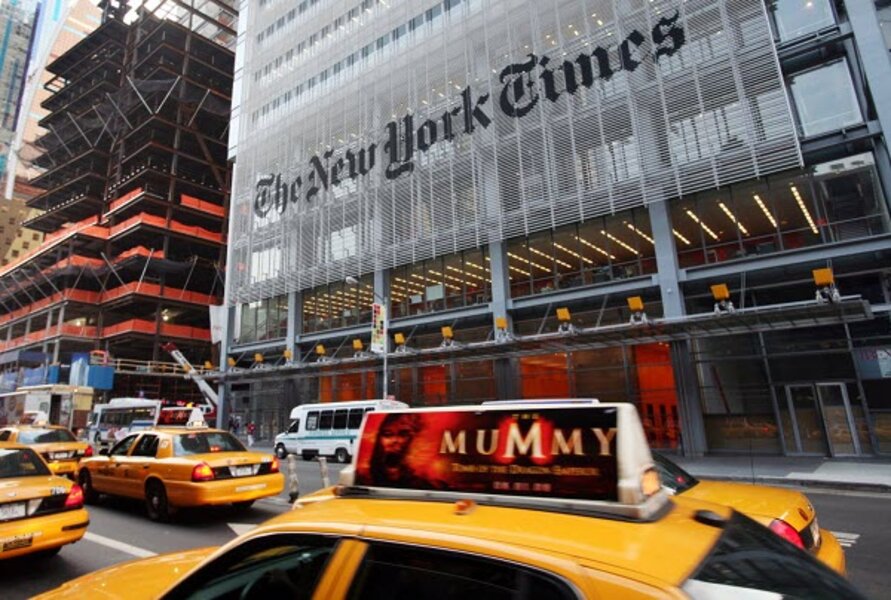Los Angeles Times joins the crowd, erects pay wall for the news online
Loading...
| Los Angeles
The Los Angeles Times on Monday joined a growing number of newspapers who are asking consumers to pay for what they have been getting for free: content on the website.
Southern California newshounds who want more than their 15 free online articles per month can get a one-month trial for the discounted price of 99 cents. After that, they can choose from a menu of options, including a digital-only plan for $3.99 per week and, interestingly, one for only $1.99 a week that includes all digital access plus the Sunday print paper.
Two years ago, The Wall Street Journal was the only major newspaper with a digital pay model. A year ago, The New York Times began charging online customers for access if they read more than 20 articles a month.
Momentum is building behind this source of revenue for ailing newspapers. Other individual newspapers such as The Boston Globe have jumped on the bandwagon, and the Gannett newspaper chain has just announced that it will put some 80 of its community newspapers around the country behind a pay wall by the end of 2012.
There are enormous financial pressures driving this experiment with pay walls, points out Mark Jurkowitz, from the Pew Research Center’s Project for Excellence in Journalism. A study released Monday of some 13 companies that own 330 print dailies shows that for every seven dollars lost in print advertising, the newspapers are only picking up a dollar in digital revenues.
But, he points out, it is far too early to assess the potential of the pay wall model to change this dire downward trend line.
“This is a nascent industry,” he says, “and while more and more papers are experimenting with different kinds of pay walls, we think it’s far too early to develop any meaningful data on their effectiveness.”
Some analysts question whether print journalism has a future with the upcoming generation of social-media-savvy users, accustomed to getting their digital news for free.
“The horse has left the barn on this one,” says Fordham University Professor Paul Levinson, author of “New New Media.” The attempt to create premium pricing on the Internet will only hurt newspapers further, he says, because it flies in the face of the underlying mechanism of the Digital Age.
“It inhibits connectivity,” he says, meaning that it slows down a user’s ability both to find an article in a search and then to share it with other people. Users who locate a premium-priced article through an online search would be asked to pay before accessing it. It is also more difficult to quickly share such content via Twitter or Facebook or any other social media.
“Fast and easy connectivity is the life blood of the Internet,” he says, "and anything that does not keep pace with that will shrink.”
Pay walls may prove effective for outlets with particular strengths such as size or exclusivity, says Anthony DePalma, a journalism professor at Seton Hall University who worked at The New York Times for 22 years before leaving in 2008.
“The pay wall may work for a few very large publications, and those that are very local and therefore unique,” he writes via e-mail But, he adds, “the landscape for all those in between is gloomy indeed.”
He is not willing to throw in the towel, however.
“This matters greatly to us as a society because without some way to provide support for the difficult but critically-important work of journalism, much of it will go undone,” Mr. DePalma says.
One way to look at it, he suggests, is to compare news with bus service.
“Without some kind of financial support, only the most lucrative bus lines into Manhattan can survive. The difficult work of picking up working-class people and getting them to and from work, home, the hospital, etc. gets ignored if not for some kind of public commitment. Without the legacy media there will be news, much of it available free of charge, but not enough of it will be the kind that really matters,” he adds.
Others say this sort of hand-wringing is precisely what is preventing the newspaper industry from adapting to a digital world, with all new rules of the road.
“Competition is what will make these outlets better, not worse,” says Chris Tolles, chief executive officer of Topix, the largest online local forum site in the US. “They have to make the case that what they are offering has real value.”
He notes that he is a paid digital subscriber to The New York Times for that reason.
“I value what they do and don’t want it to go away,” he says. But newspapers, he adds, need to be more adaptable as they try to make this transition – and stop trying to recover the glory days back when they were cash cows with upward of 20 percent profit margins.
“Those monopoly days are gone forever,” he says. “Journalists need to be more humble.”
[Editor's note: A previous version of this story mischaracterized the subscription options for digital access.]





